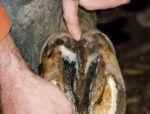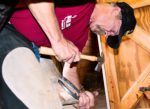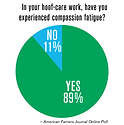Advertise Follow Us
Katie Navarra
Katie Navarra is a freelance writer who draws from her experiences owning and showing horses, and interviewing the industry’s leading professionals.
ARTICLES
Foot trimming basics can reduce the risk of anaerobic bacterial infections
Read More
International Hoof-Care Summit
6 Questions with Roy Bloom
By Katie Navarra
posted on
December 18, 2021
| Posted in Business Practices, Education, Equipment, Forging
Read More
Boost Your Farrier Practice with Social Media
Platforms offer benefits for your business and industry, but poor conduct can be costly
By Katie Navarra
posted on
November 1, 2021
Read More
Proven Strategies for Calming Nervous Horses for Hoof Care
Simple techniques can make footcare an easier task
By Katie Navarra
posted on
September 10, 2021
Read More
Farrier Tip
Legal Implications High When Farriers Sedate Horses
By Katie Navarra
posted on
May 21, 2021
| Posted in Business Practices, Clients, Diseases, Lamenesses, Safety & Healthcare, Therapeutic Shoeing
Read More
Farriers Should Not Sedate Clients’ Horses
An improper injection can lead to significant medical and legal liabilities
By Katie Navarra
posted on
May 5, 2021
Read More
Understand Breakover and the Implications of Manipulating it
Definitions vary among hoof-care professionals, but improperly influencing it can produce significant problems
By Katie Navarra
posted on
January 8, 2021
Read More
Tips for Identifying and Managing Compassion Fatigue
Emotional highs and lows of caring for clients’ horses can take a toll
Read More
Hoof Health Hinges on Dynamic Climates
Ever-changing environment can leave your clients’ horses struggling to adapt
By Katie Navarra
posted on
September 13, 2020
| Posted in Clients, Disciplines & Breeds, Shoeing, Therapeutic Shoeing, Trimming
Read More
Pressure Plate Analysis Measures Dynamic Weight Distribution
Ghent University researcher’s findings can influence trimming and shoeing for individual hoof-care cases
By Katie Navarra
posted on
July 3, 2020
| Posted in Education, Equipment, Shoeing, Therapeutic Shoeing, Trimming
Read More
Top Articles
Current Issue
American Farriers Journal
American Farriers Journal is the “hands-on” magazine for professional farriers, equine veterinarians and horse care product and service buyers.
How Understanding Equine Behavior Keeps You Safe
How Equine Handedness Influences Hooves & Conformation
Will the PAST Act Remain a “Sad Little Scrap of Paper?”
Current Issue
Special Report For Equine Veterinarians
American Farriers Journal is the “hands-on” magazine for professional farriers, equine veterinarians and horse care product and service buyers.
Must Read Free Eguides
Download these helpful knowledge building tools
- Caring for Your Horse During a Pandemic
- CBD Products Have Promise for Farriers, but Buyer Beware
- Sharpening Knives with a Buffer
- Winter Hoof Care
Videos
Farrier Education: Heartland Horseshoeing School
Farriery requires knowledge and skills to provide proper equine hoof care. In this series, sponsored by VICTORY, American Farriers Journal visits Heartland Horseshoeing School in Lamar, Mo. In this edition, Chris Gregory discussed his journey to becoming an educator, his focus in teaching farrier students and the state of farrier education.
Events
EMS (IR) and PPID: Diagnosis and Management (Part 1) Webinar
Date: 02/26/24
Location:
View Event
Top Directory Listings
Life Data Labs Inc
Life Data Labs Inc. is a dedicated product manufacturer committed to producing premium quality animal nutrition and health products through continuous product improvement and new product development. First-class ingredients, fresh products, consistent high quality and scientifically proven effectiveness are the principal features of Life Data Labs animal health products. And that's why they've produced the #1 recommended hoof supplement by farriers for 12 consecutive years.
Kawell USA
Kawell develops and produces copper alloy horseshoes and inserts, giving horses the care that they need to fight issues associated with white line disease, seedy toe and thrush.
SmartPak
From the feed room to the tack room, SmartPak offers innovative solutions to help riders take great care of their horses. SmartPak was founded in 1999 with the introduction of the patented SmartPak™ supplement feeding system. The revolutionary, daily dose SmartPaks are custom-made for your horse, individually labeled and sealed for freshness.

















